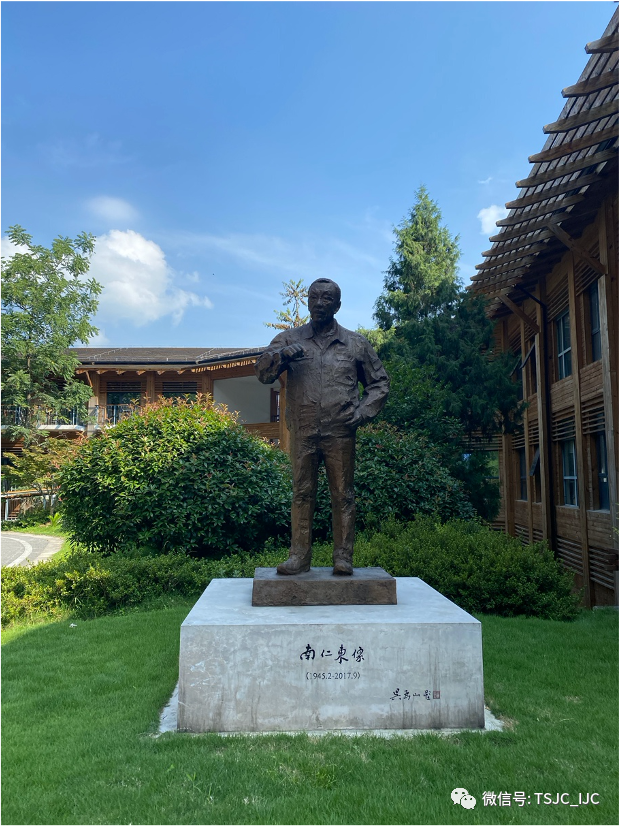25
2021.06
A BOLD IDEA
"Do you know how long 500 meters is?"
Twenty-eight years ago in Tokyo, a Chinese astronomer named Nan Rendong was seriously thinking about this question that foreign scholars called in -- A few minutes ago, Nan, and several other astronomers also from China said at the International Union of Radio Science General Assembly and Scientific Symposium that they wanted to build a large telescope measuring 500 meters in aperture, right there, in China.
The bold idea caused questioning voices immediately. Even in the later design and construction process, these voices never disappeared. After all, the worldwide largest radio telescope back then was the Arecibo Telescope in American-built location in Puerto Rico, with the Aperture of 350 meters. The biggest one in China, on the other hand, was merely less than 30 meters.

The sculpture of Nan Rendong, Photo by Du Ke
Everyone seemed to feel that these Chinese scientists and their bold idea was whimsical and impractical.
No one seemed to expect that this fanciful telescope could become a reality 23 years later.
Located in southwestern China’s Guizhou province, the Five-hundred-meter Aperture Spherical radio Telescope, also named "FAST", made its first debut in October 2017, together with its astonishing sensitive detection capability of the cosmic lighthouses: pulsars.
According to Zhao Baoqing, head of the on-site office of FAST, all the telescopes across the world except FAST can find about 50 pulsars a year, while FAST itself can find about 150 pulsars in last two years
"You can't sail on the sea without lighthouses, and you can't cross the land without navigation, but what about traveling in space?" Zhao said.
"That’s why we want to find pulsars which is one of our emphasis of the work. Pulsars are like lighthouses for us as we travel through space, telling us where to go."
STUBBORN PEOPLE
As the discoverers of cosmic lighthouse, the current FAST team is mainly composed of those born in the 1970s and 1980s. After the reform and opening up, science revived, and young people were encouraged to devote themselves to the field of science.
In the FAST base, researchers from all over the country have their own personalities and preferences, but they have something in common: persistency in science.
A total of 2089.4 kilometers --- the distance from Guizhou to Beijing --- is a customary journey for many members of the FAST team.
The whole team is divided into a technical research and development team in Beijing and an equipment operation and daily maintenance team in Guizhou.
For many of them, they have to go back and forth between the two places through the whole year, so does Jiang Peng, the chief engineer of FAST. Jiang lives in Beijing with his family, yet he needs to work at the base in Guizhou more than half of the year.
"Others often regard us as a group of stubborn people who only know to build a telescope and don't care about anything else," he said.
The team members devote all their time and energy to the construction of the telescope, while entertainment activities such as romantic relationship or video games seem to have little to do with them.
Becoming a member of the FAST team needs careful consideration, especially for the young generations, since the daily life here is definitely far from graceful. There are many voices around them saying that feel sorry for them, and some people think that it is better for young people to have a more varied and colorful life.
However, rare left the FAST team during the more than 8,000 days and nights over the past 27 years. This group of stubborn scientific researchers have always been redoubling their efforts. There is only one thing in their minds: to succeed in constructing their telescope.

A Logo of FAST base in Pingtang county, Guizhou, China, Photo by Du Ke
THE ONE THING
"FAST is not a traditional telescope," said Jiang Peng, adding that the structure of the telescope is extremely complicated.
According to Jiang, the reflective surface that can flexibly change from a spherical surface to a parabolic surface. The drive and control system can adjust the observation angle and position at any time. Both features are new to build similar telescope, which means that there is no experience for the FAST team to learn from.
"Every detail that is overlooked may lead to the failure of the entire project," Zhao said.
To make a brand-new product that has never been seen before from an idea to a reality in just a few years, they must consider all potential problems.
"The years from 2017 to 2019 are the most difficult time for us," Jiang recalled.
"In those three years, we hardly returned home. The entire research team even had to celebrate the Spring Festival at the base."
At that time, the telescope had just been built, and the team faced arduous debugging work. It was a common occurrence for them to work until four o'clock in the morning.
And finally, they made it. Their success, just as Gary Keller, an American writer said in his book called The One Thing, is "a result of narrowing your concentration to one thing".
COURSE ON PURPOSE
Concentration enabled them to build FAST, the world's largest and most sensitive radio telescope, but the completion of FAST is just their first victory, which Jiang conceded it has room for improvement.
In the realization of application value, Jiang pointed out that they did not give full play to the functions of FAST, and they tried to apply FAST to more fields. Besides, researchers are constantly exploring how to upgrade their technology.
Even in the area of pulsar discovery where FAST has excelled at, it has a lot of work to do.
"Finding a pulsar is just the first step, it's not clear if the pulsar you find is the one you want,” Jiang added.
Pulsar discovery requires a lot of accumulation to find a special pulsar. Jiang said: "The probability of finding a special one in a hundred is completely different from that of finding a special one in a thousand."
The FAST team hopes to find more specific pulsars, such as those with extremely fast rotation period or large mass, attempting to create new explanations for pulsar physics.
"The current development of astronomy in China is not as optimistic as everyone seems," Jiang said.
"We still have a lot of work to do."
Reporter|Du Ke, Duan Meixi

2025.12.16 15:15
16
2025.12
16
2025.12
16
2025.12
 28:32
28:32
2025.06.19 08:55